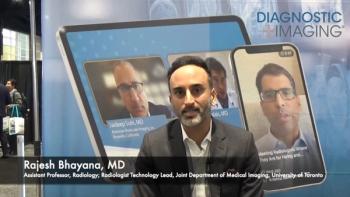
Fibroid patients build case with successful pregnancies
Successful pregnancies following uterine fibroid embolization are debunking the theory that the procedure should not be recommended for women who want to conceive despite having heavy fibroid volume. Among a cohort of more than 1200 embolization patients at an English hospital, 43 of 98 women who tried to conceive have been able to do so.
Successful pregnancies following uterine fibroid embolization are debunking the theory that the procedure should not be recommended for women who want to conceive despite having heavy fibroid volume. Among a cohort of more than 1200 embolization patients at an English hospital, 43 of 98 women who tried to conceive have been able to do so.
Researchers at Royal Surrey County Hospital in Guildford, U.K., have tracked pregnancy incidence and outcomes in their large fibroid embolization population. The 43 women have had 53 pregnancies to date, with the following results:
29 successful births;
four ongoing pregnancies;
four terminations;
13 miscarriages; and
one ectopic pregnancy.
Those figures bolster an earlier and smaller report from the Ontario UFE Trial, which logged 24 pregnancies in 21 women among 555 treated in Canada in a report published in the January 2005 issue of Obstetrics & Gynecology. Those post-UFE pregnancies led to 18 live births, including nine cesarean deliveries, according to lead research Gaylene Pron, Ph.D., an epidemiologist at the University of Toronto. Four women miscarried, and two elected to have their pregnancies terminated.
Considering that women who undergo fibroid treatment tend to be older than the average child-bearing population, data on miscarriages and pregnancy complications are consistent with the general obstetrics literature, said lead investigator Dr. Woodruff Walker. The women in the Surrey cohort who had successful births averaged 35.8 years of age, while those who miscarried were significantly older at an average of 41.8 years. The miscarriage rate of 24.5% is within normal range for that age.
Women who had had fibroid embolization were far more likely than their peers to deliver by cesarean-76% of the cases-probably because their obstetricians treated their deliveries with extra caution. Intrauterine growth restriction, one of the chief concerns about fibroid embolization and its effect on pregnancy, was no more frequent in this population than in the general literature, Walker said.
The population of successful pregnancies includes several women who had undergone myomectomy before, concurrent with, or following embolization.
The average time from fibroid embolization to delivery was 32 months. Among the 43 women, 18 had previously received infertility treatment for 18 months to seven years.
With only a few published articles demonstrating UFE's safety for women who hope to become pregnant, the ob/gyn community has been hesitant to embrace it for this population. In a February 2004 statement, the American College of Obstetricians and Gynecologists wrote that the procedure was "investigational or relatively contraindicated in women wishing to retain fertility."
With new data in hand, Walker hopes to change that reluctance.
"It is scientifically invalid to say that no patient wishing to become pregnant should have uterine fibroid embolization," Walker said. "It's not a tenable position."
Newsletter
Stay at the forefront of radiology with the Diagnostic Imaging newsletter, delivering the latest news, clinical insights, and imaging advancements for today’s radiologists.




























